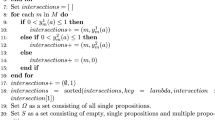Abstract
We are interested in the problem of multi-source information fusion in the case when the information provided has some uncertainty. We note that sensor provided information generally has a probabilistic type of uncertainty whereas linguistic information typically introduces a possibilistic type of uncertainty. More generally, we are faced with a problem in which we must fuse information with different types of uncertainty. In order to provide a unified framework for the representation of these different types of uncertain information we use a set measure approach for the representation of uncertain information. We discuss a set measure representation of uncertain information. In the multi-source fusion problem, in addition to having a collection of pieces of information that must be fused, we need to have some expert provided instructions on how to fuse these pieces of information. Generally these instructions can involve a combination of linguistically and mathematically expressed directions. In the course of this work we begin to consider the fundamental task of how to translate these instructions into formal operations that can be applied to our information. This requires us to investigate the important problem of the aggregation of set measures.
Similar content being viewed by others
References
Alsina C., Trillas E., Valverde L. (1983) On some logical connectives for fuzzy set theory. Journal of Mathematical Analysis and Applications 93: 15–26
Appadoo S. S., Bhatt S. K., Bector C. R. (2008) Application of possibility theory to investment decisions. Fuzzy Optimization and Decision Making 7: 5–57
Beliakov G., Pradera A., Calvo T. (2007) Aggregation functions: A guide for practitioners. Springer, Heidelberg
Choquet G. (1953) Theory of capacities. Annales de l’Institut Fourier 5: 131–295
Dubois D., Prade H. (1982) A class of fuzzy measures based on triangular norms. International Journal of General Systems 8: 43–61
Dubois D., Prade H. (1988) Possibility theory: An approach to computerized processing of uncertainty. Plenum Press, New York
Dubois D., Prade H. (2010) Formal representations of uncertainty. In: Bouyssou D., Dubois D., Pirlot M., Prade H. (eds) Decision-making process. Wiley, New York
Fodor J. C., Yager R. R., Rybalov A. (1997) Structure of uni-norms. International Journal of Uncertainty, Fuzziness and Knowledge-Based Systems 5: 411–427
Herrera F., Alonso S., Chiclana F., Herrera-Viedma E. (2009) Computing with words in decision making: Foundations, trends and prospects. Fuzzy Optimization and Decision Making 8: 337–364
Klement E. P., Mesiar R., Pap E. (2000) Triangular norms. Kluwer, Dordrecht
Klir G. J. (2006) Uncertainty and information. Wiley, New York
Liu H. T., Wei N. C., Yang C. G. (2009) Improved time-variant fuzzy time series forecast. Fuzzy Optimization and Decision Making 8: 45–65
Llinas, J., Nagi, R., Hall, D. L., & Lavery, J. (2010). A multi-disciplinary university research initiative in hard and soft information fusion: Overview, research strategies and initial results. In Proceedings of the 13th international conference on information fusion (Fusion 2010), Edinburgh, UK, Unpaginated.
Murofushi, T. (1992). A technique for reading fuzzy measures (i): The Shapely value with respect to a fuzzy measure. In Proceedings Second Fuzzy Workshop (pp. 39–48). Nagaoka, Japan (in Japanese).
Murofushi, T., & Soneda, S. (1993). Techniques for reading fuzzy measures(iii): Interaction index. In Proceedings 9th fuzzy system symposium (pp. 693–696). Sapporo (In Japanese).
Murofushi T., Sugeno M. (2000) Fuzzy measures and fuzzy integrals. In: Grabisch M., Murofushi T., Sugeno M. (eds) Fuzzy measures and integrals. Physica-Verlag, Heidelberg, pp 3–41
Pedrycz W., Gomide F. (2007) Fuzzy systems engineering: Toward human-centric computing. Wiley, New York
Shapley L. S. (1953) A value for n-person games. In: Kuhn H. W., Tucker A. W. (eds) Contributions to game theory. Princeton University Press, Princeton, NJ, pp 307–317
Sugeno M. (1977) Fuzzy measures and fuzzy integrals: A survey. In: Gupta M. M., Saridis G. N., Gaines B. R. (eds) Fuzzy automata and decision process. North-Holland, Amsterdam, pp 89–102
Sugeno, M., & Murofushi, T. (1987). Choquet integral as an integral form for a class of fuzzy measures. In Proceedings of the second IFSA congress (pp. 408–411). Tokyo.
Takagi T., Sugeno M. (1985) Fuzzy identification of systems and its application to modeling and control. IEEE Transactions on Systems, Man and Cybernetics 15: 116–132
Yager R. R. (1988) On ordered weighted averaging aggregation operators in multi-criteria decision making. IEEE Transactions on Systems, Man and Cybernetics 18: 183–190
Yager R. R. (2002) On the cardinality index and attitudinal character of fuzzy measures. International Journal of General Systems 31: 303–329
Yager R. R. (2010) Criteria satisfaction under measure based uncertainty. Fuzzy Optimization and Decision Making 9: 307–331
Yager R. R., Filev D. P. (1994) Essentials of fuzzy modeling and control. Wiley, New York
Yager R. R., Rybalov A. (1996) Uninorm aggregation operators. Fuzzy Sets and Systems 80: 111–120
Zadeh L. A. (1971) Similarity relations and fuzzy orderings. Information Sciences 3: 177–200
Zadeh L. A. (1978) Fuzzy sets as a basis for a theory of possibility. Fuzzy Sets and Systems 1: 3–28
Zadeh L. A. (1996) Fuzzy logic = computing with words. IEEE Transactions on Fuzzy Systems 4: 103–111
Zadeh L. A. (1999) From computing with numbers to computing with words-From manipulation of measurements to manipulations of perceptions. IEEE Transactions on Circuits and Systems 45: 105–119
Zadeh L. A. (2002) Toward a perception-based theory of probabilistic reasoning with imprecise probabilities. Journal of Statistical Planning and Inference 105: 233–264
Zadeh L. A. (2006) Generalized theory of uncertainty (GTU)-principal concepts and ideas. Computational Statistics and Data Analysis 51: 15–46
Author information
Authors and Affiliations
Corresponding author
Rights and permissions
About this article
Cite this article
Yager, R.R. A measure based approach to the fusion of possibilistic and probabilistic uncertainty. Fuzzy Optim Decis Making 10, 91–113 (2011). https://doi.org/10.1007/s10700-011-9098-1
Published:
Issue Date:
DOI: https://doi.org/10.1007/s10700-011-9098-1




